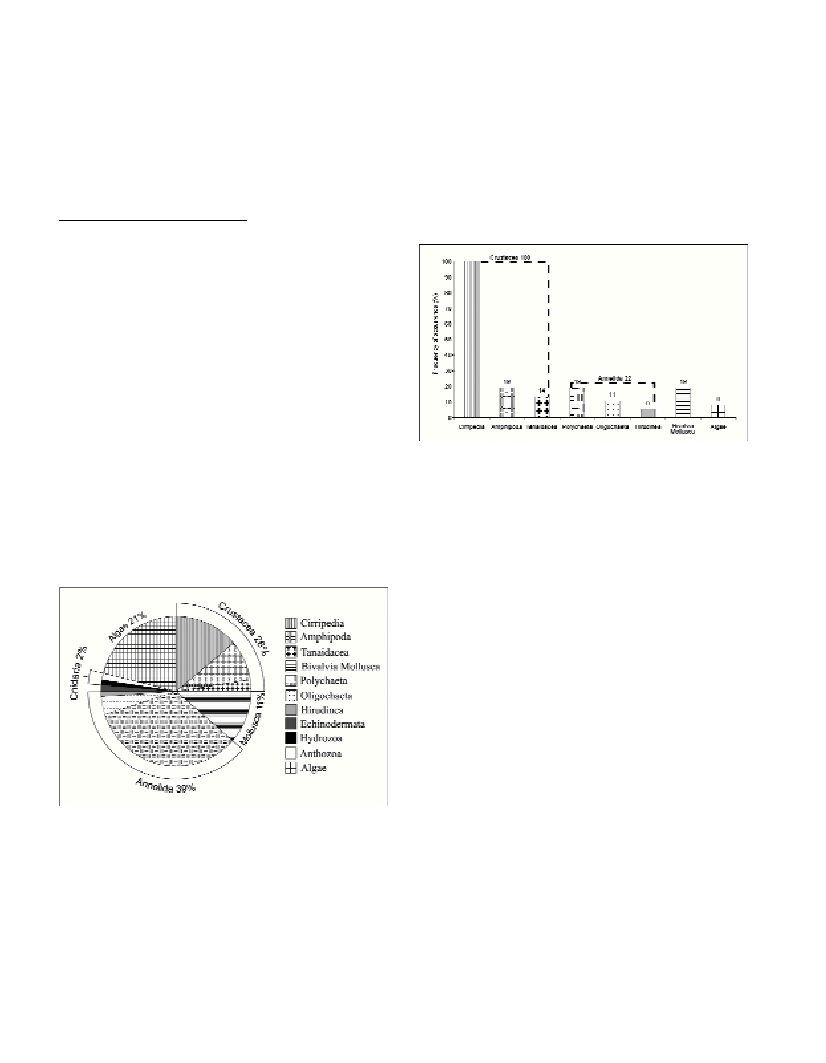COMPOSITION OF THE EPIBIOTIC ASSEMBLAGE ASSOCIATED WITH CARETTA CARETTA
(LINNAEUS, 1758)
Kitsos M.-S.
1 *
, Christodoulou M.
1
, Arvanitidis Ch.
2
, Mavidis M.
1
, Kirmitzoglou I.
1
, Koukouras A.
1
1
Department of Zoology, School of Biology, Aristoteleio University of Thessaloniki, Greece - * akoukour@bio.auth.gr
2
Institute of Marine Biology of Crete, Iraklio, Crete, Greece
Abstract
Thirty-seven loggerhead turtles washed ashore in northern Greece were sampled. A total of 63 macrobenthic species and 17 species of
algae were identified from the material of which 47 macrobenthic species and 13 species of algae are reported for the first time as epibionts
of the loggerhead turtle.
Key words: Caretta caretta, epibionts
Rapp. Comm. int. Mer Médit., 37,2004
529
Introduction
The existing information on the composition of the assemblage
associated with Caretta caretta, is little known and limited to a rather
small number of papers (1-6). The aim of this study is to give new
information on the composition of the assemblage associated with the
loggerhead turtle.
Materials and Methods
Thirty-seven, loggerhead turtles washed ashore from April 2000 to
January 2003 in the northern Aegean Sea were sampled. All epibionts
were carefully removed from various parts of the turtle’s body and
their position recorded. In the laboratory all specimens were identified
and counted.
Results and Discussion
The analysis of the collected material revealed the presence, of 63
macrobenthic species (4.824 individuals) as well as the presence of 17
species of algae.
Annelida was the most dominant taxonomic group with 31 species
(Fig. 1). Only two previous studies have reported species of Annelida
as epibionts of Caretta caretta(2, 3). Among Annelida, Polychaeta
are represented by the highest percentage (34%; 27 species). Twenty-
five of these species are reported for the first time as epibionts of
Caretta caretta. Oligochaeta and Hirudinea were represented by 3 and
1 species respectively. This is the first time Oligochaeta are reported
as epibionts of Caretta caretta.
Crustacea are second in species number (20 species). However, in
previous studies this group was reported as the most dominant (2, 3).
Among Crustacea, Cirripedia Thoracica had the highest percentage
(14%; 11 species). Amphipoda and Tanaidacea were represented by 7
and 2 species respectively. The amphipod Caprella andrae Mayer,
1890 was the most abundant species. The tanaidacean Leptochelia
savignyi (Krřyer, 1842)is reported for the first time as an epibiont of
C. caretta.
The most abundant species of algae was Cladophora prolifera
(Roth) Kützing. Of the 17 species found, 13 are reported for the first
time as epibionts of C. caretta.
Concerning Bivalvia Mollusca (9 species), with the exception of
Ostrea edulis(Linnaeus, 1758), all other species found, are reported
for the first time as epibionts of C. caretta.
Crustacea had the highest frequency of occurrence (100%) (Fig. 2)
due to the very high value (100%) of the thoracican cirriped
Chelonibia testudinaria(Linnaeus, 1758). This species has been
reported as the most frequent epibiont of the loggerhead turtle (2, 3,
5, 9). The group of Annelida were second, with Polychaeta having the
highest percentage. Bivalvia Mollusca had the same frequency
percentage with Polychaeta while algae had a low frequency
percentage.
Most of the species found, were attached on the peripheral plates of
the upper part of the turtle’s carapace, while all algae were mainly
found in the anterior and posterior part of the upper surface of the
carapace.
Concerning the biogeography of all the epibiont species found,
60% are cosmopolitan 31% are Atlanto-Mediterranean and only 9%
are endemics. The high percentage of cosmopolitan species should be
attributed to the migratory habits of Caretta caretta.
References
1-Frazier, J., D. Margaritoulis, K. Muldoon, C.W. Potter, J. Rosewater, C.
Ruckdeschel, S. Salas, 1985. Epizoan communities on marine turtles. I.
Bivalve and gastropod mollusks. Pubbl. Staz. zool. Napoli, (I., Marine
ecology),6(2): 127-140.
2-Caine, E.A., 1986. Carapace epibionts of nesting loggerhead sea
turtles: Atlantic coast of U.S.A. Journ. exp. mar. Biol. Ecol., 95: 15-26.
3-Frick, M.G., K.L. Williams, M. Robinson, 1998. Epibionts associated
with nesting loggerhead sea turtles (Caretta caretta) in Georgia, U.S.A.
Herpetol. Rev.,29(4): 211-214.
4-Abel Sentúes, G., J. Espinoza-Avalos, J.C. Zurita, 1999. Epizoic algae
of nesting sea turtles Caretta caretta (L.) and Chelonia mydas (L.) from the
Mexican Caribbean. Bull. Mar. Sci.,64(1): 185-188.
5-Gramentz, D., 1988. Prevalent epibiont sites on Caretta caretta in the
Mediterranean Sea. Naturalista sicil., IV, XII (1-2): 33-46.
6-Kitsos, M.- S., M. Christodoulou, S. Kalpakis, M. Noidou, A.
Koukouras, 2003. Cirripedia Thoracica associated with Caretta caretta
(Linnaeus, 1758) in the Northern Aegean Sea. Crustaceana, 76(4): 403-
409.
Fig. 1. Participation percentages of the various taxonomic groups in the
assemblage associated with Caretta caretta.
Fig. 2. Frequency of occurrence of the main taxonomic groups of the
epibionts of Caretta caretta.

